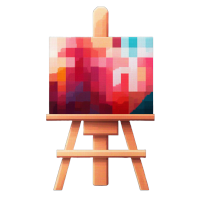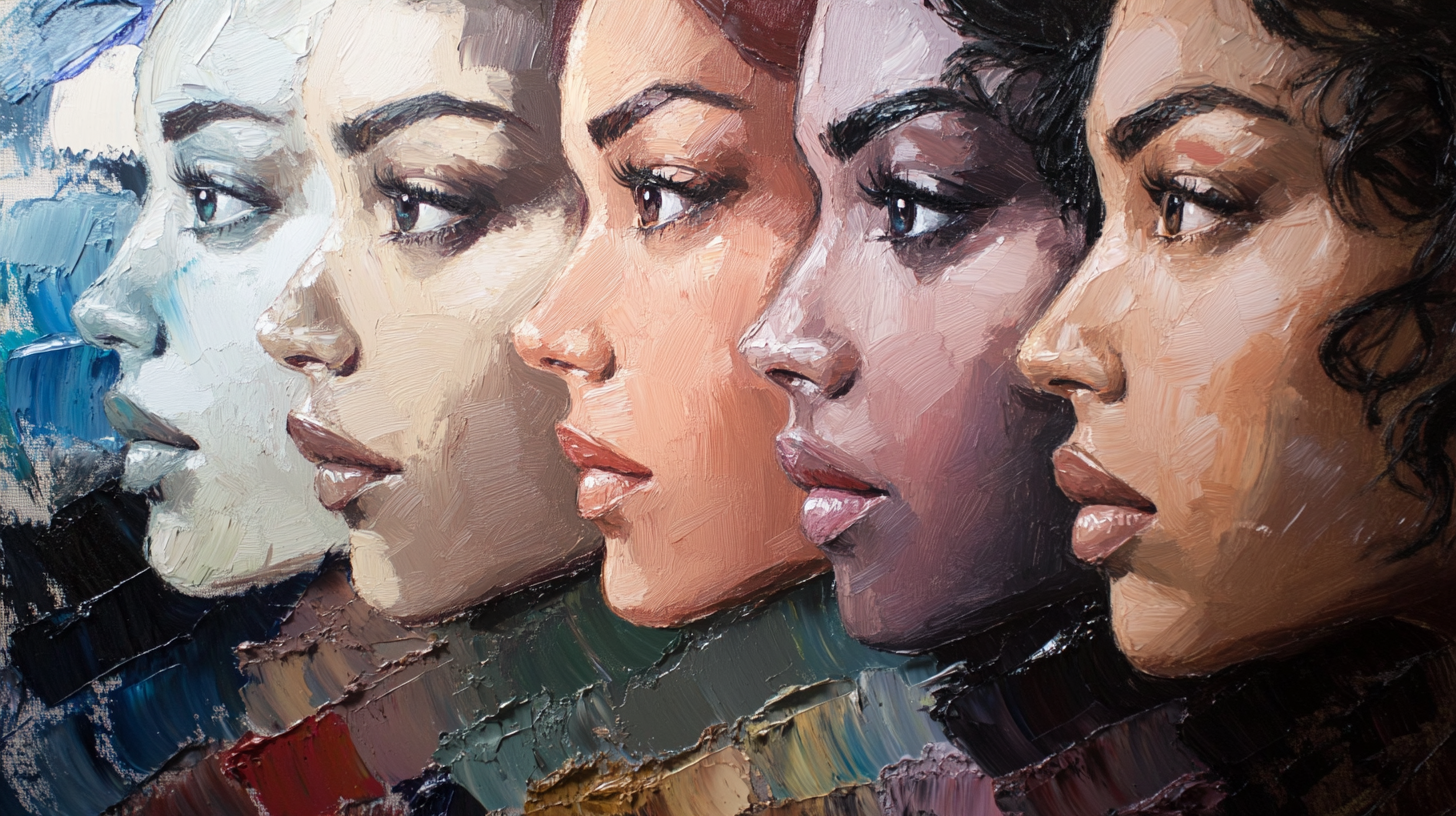Mixing Oil Colors for Realistic Skin Tones: Step-by-Step Tutorial
Creating lifelike skin tones in portrait painting is one of the most challenging yet rewarding aspects of oil painting. In this tutorial, designed specifically for oil painting beginners and portrait artists alike, we'll guide you through practical steps to achieve natural, realistic complexions. We'll dive into the fundamentals of mixing oil colors for skin tones, explore color theory, and provide a detailed, step-by-step process to help you master the art of oil paint skin tone mixing. Whether you're tackling subtle nuances in light and shadow or experimenting with advanced oil painting portrait techniques, this guide will serve as your comprehensive skin tone mixing guide.
Skip color mixing—get your oil paint palette & mixing recipes now!
✨ Select your reference image and get an instant oil paint color palette with precise mixing recipes. 🎨
Get your oil paint color palette now1. Introduction
Portrait artists often seek to capture the unique essence of their subjects, and one of the key elements in achieving a realistic portrait is the ability to mix oil colors for skin tones accurately. Realistic skin tones oil painting is not merely about replicating a single flat color; it's about blending a spectrum of hues that represent the subtle variations found in natural skin.
In this tutorial, you will learn:
- How to mix oil colors for skin tones by starting with a basic palette and gradually building complexity.
- The role of light and shadow in creating depth.
- Techniques to achieve a harmonious balance between various hues.
- Essential oil painting portrait techniques that enhance the lifelike quality of your artwork.
By the end of this guide, you'll have a solid foundation for approaching oil paint skin tone mixing with confidence and precision.
2. Materials and Setup
Before diving into the mixing process, it's important to ensure you have the right materials and a conducive workspace. Here's what you'll need:
Essential Materials:
- Oil Paints: A limited palette is ideal for beginners. Consider the following:
- Titanium White
- Cadmium Red (or a softer red like Alizarin Crimson)
- Yellow Ochre
- Burnt Sienna
- Raw Umber
- Ultramarine Blue (for cool tones)
- Viridian or a green variant (for subtle undertones)
- Mediums and Solvents: Linseed oil (or a similar medium) for consistency and odorless mineral spirits or turpentine for thinning paints and cleaning brushes.
- Palette: A glass or wooden palette to mix your colors.
- Brushes: A variety including flat, filbert, and detail brushes.
- Canvas or Painting Surface: A primed canvas or oil painting paper.
- Palette Knife: For evenly mixing large quantities of color.
- Rags or Paper Towels: For wiping brushes and cleaning up.
- Lighting: Good quality natural or daylight-balanced artificial lighting for accurate color perception.
Setting Up Your Workspace:
- Ensure your workspace is well-ventilated.
- Arrange your materials within easy reach.
- Prepare a small "color lab" area on your palette for testing mixes before applying them to your canvas.
Having these materials at hand not only streamlines the process but also helps you focus on developing a reliable method for mixing oil colors for skin tones.
3. Understanding Color Theory for Skin Tones
To effectively mix realistic skin tones, it's essential to understand the basics of color theory, especially as it pertains to human skin. Skin tones are rarely a single color—they consist of a range of hues and values. Here are some key points to consider:
The Role of Primary Colors:
Red, Yellow, and Blue form the basis of most color mixes. In skin tone mixing, red and yellow typically serve as the primary warm hues. White and Black are used to adjust the value (lightness or darkness) of the mix without drastically altering the hue.
Undertones and Overtones:
Undertones are the subtle hues that appear beneath the surface color of the skin—they can include pinks, greens, or blues depending on the complexion. Overtones are the surface colors we immediately see, often a mix of warm (yellow, red) and cool (blue, green) elements.
The Influence of Light:
Skin is three-dimensional; its color shifts in response to light. Light areas will be warmer and lighter, while shadowed areas will often have cooler and darker tones. Ambient reflections from the environment can also affect the appearance—for example, outdoor scenes may introduce a cooler, bluish tint, while indoor lighting may warm the skin tone.
Creating a Custom Palette:
Begin with a base mix using your primary colors. Then adjust by adding varying amounts of white for highlights or black/darker hues for shadows. Experiment with small doses of ultramarine blue or viridian if you need to cool an overly warm mix.
Understanding these principles forms the backbone of effective mixing oil colors for skin tones. Every individual's skin is unique—your goal is to craft a palette that allows flexibility for different scenarios.
4. Step-by-Step Process for Mixing Realistic Skin Tones
4.1 Establishing a Base Mix
Step 1: Start with a Neutral Base
Begin with a neutral base as the foundation for your skin tone. This usually involves a blend of:
- Yellow Ochre: Provides warmth.
- Cadmium Red or Alizarin Crimson: Adds depth and a natural blush.
- Burnt Sienna: Brings in an earthy, muted tone.
- Titanium White: Lightens the mix as needed.
Procedure: Squeeze a small amount of each color onto your palette, mix them together using a palette knife to achieve a warm, muted brown resembling a neutral skin undertone, and test the color on a scrap piece before making adjustments.
Tip: A common starting ratio might be 2 parts Yellow Ochre, 1 part Red, 1 part Burnt Sienna, with a touch of Titanium White.
4.2 Incorporating Undertones
Step 2: Adjusting the Undertones
Once you have your neutral base, infuse subtle variations by:
- Identifying the subject's undertone:
- Warm Undertones: Increase Yellow Ochre and perhaps a bit more Cadmium Red.
- Cool Undertones: Add a hint of ultramarine blue or a diluted form of viridian. (Small amounts go a long way!)
- Mixing small batches on your palette and adjusting incrementally.
- Observing the impact of white: Gradually add Titanium White to create highlights, but adjust if the mix becomes too muted.
4.3 Adjusting for Light and Shadow
Step 3: Creating Depth with Light and Shadow
- Define the Light Areas: Identify where light hits (forehead, nose, cheekbones) and mix a variant of your base with extra white and a touch more yellow or red.
- Develop the Shadow Areas: For shadows, mix a variant using a bit of ultramarine blue or Burnt Umber—taking care to maintain some warmth.
- Transitional Zones: Use a soft brush to blend edges between light and shadow. A mid-tone mix (combining aspects of both highlight and shadow mixes) creates smooth transitions.
Pro Tip: Use glazing techniques with thin, translucent layers to gradually build depth and vibrancy.
5. Practical Tips for Oil Paint Skin Tone Mixing
5.1 Experiment and Observe
- Small Batches First: Mix small amounts to test ratios and avoid waste.
- Work Under Consistent Lighting: Use natural or daylight-balanced lighting for accuracy.
- Document Your Ratios: Keep a journal ("2 parts Yellow Ochre, 1 part Red, 1 part Burnt Sienna, a dash of White") for future reference.
5.2 Use a Limited Palette
- Focus on Versatility: A limited palette forces you to learn to mix a wide range of tones.
- Clean Mixing Surface: Always start with a clean palette to prevent contamination.
5.3 Layering and Glazing Techniques
- Underpainting: Begin with a neutral underpainting to guide overall values and form.
- Glazing: Once the underpainting is dry, apply thin glazes to build depth gradually.
- Drying Time: Allow each layer to dry fully before applying the next to prevent muddy colors.
5.4 Adjusting for Different Ethnicities
- Diversity in Tones: Different subjects may require subtle adjustments in warm and cool hues.
- Subtle Adjustments: For warmer complexions, enhance warm hues; for cooler or olive tones, incorporate a touch of blue or green.
- Reference Photos: Study photos or work from live models to capture realistic nuances.
5.5 Continuous Learning
- Workshops and Classes: Take portrait painting or color theory classes for deeper insights.
- Critique and Feedback: Join art groups or online forums to refine your technique.
6. Common Pitfalls and How to Avoid Them
6.1 Over-Mixing
Issue: Over-mixing can homogenize the subtle variations in skin tones.
Solution: Work in layers, allowing each to dry before adding glazes.
6.2 Too Much White
Issue: Excessive white can create a pastel effect that lacks warmth and depth.
Solution: Use white sparingly and always in combination with your base colors; test frequently.
6.3 Incorrect Undertone Adjustment
Issue: Misjudging undertones may yield skin tones that are too red, yellow, or blue.
Solution: Regularly step back, assess under different lighting conditions, and consult a color wheel or reference photos.
6.4 Muddy Colors
Issue: Incorporating too many colors or over-complicating the mix can result in a muddy appearance.
Solution: Stick to a limited palette and build complexity gradually.
7. Practice Exercises and Assignments
Exercise 1: The Monochrome Mix
Objective: Focus on value and subtle color shifts using a single base color.
Process: Use Burnt Sienna with varying amounts of white and a touch of blue for shadows to create a value scale.
Outcome: Understand how small adjustments affect overall tone.
Exercise 2: Matching from a Photograph
Objective: Replicate a realistic skin tone directly from a reference photo.
Process: Choose a high-quality portrait, mix a base tone similar to the photo, and adjust with undertones and modifiers for highlights and shadows.
Outcome: Enhance your observational skills and learn dynamic palette adjustments.
Exercise 3: Live Model Studies
Objective: Capture the dynamic range of skin tones in real-time.
Process: Work with a live model or video reference, starting with a loose underpainting and building layers while adjusting for light and shadow.
Outcome: Improve your speed and accuracy in mixing colors.
Exercise 4: The Color Wheel Challenge
Objective: Deepen your understanding of color relationships.
Process: Create a color wheel with your limited palette, identify complementary, analogous, and triadic relationships, and experiment with skin tone mixes.
Outcome: Gain insights into balancing warm and cool hues.
Exercise 5: Layering Practice
Objective: Master glazing techniques to build depth.
Process: On a prepped canvas, apply a neutral underpainting and then thin glazes in multiple sessions—allowing each layer to dry completely.
Outcome: Develop a three-dimensional quality in your portraits.
8. Conclusion and Final Thoughts
Mixing oil colors for realistic skin tones is a journey of exploration, practice, and continuous learning. In this tutorial, we covered everything from fundamental color theory to detailed, step-by-step instructions for creating natural, dynamic skin tones. You are now equipped with a reliable skin tone mixing guide that will enhance your oil painting portrait techniques.
Key Takeaways:
- Start with a Neutral Base: Establish a solid foundation with a simple mix of Yellow Ochre, Cadmium Red (or Alizarin Crimson), Burnt Sienna, and Titanium White.
- Adjust Undertones Carefully: Recognize and balance the subtle variations in warm and cool hues.
- Balance Light and Shadow: Use highlights and shadows (with glazing techniques) for depth and realism.
- Practice, Observe, and Refine: Regular exercises—from matching photographs to live model studies—will hone your skills over time.
Remember, every portrait is unique. The more you experiment and observe the natural variations in skin tones, the better you'll be at adapting your mixes for different subjects and lighting conditions. With persistence and a willingness to experiment, you can create truly realistic skin tones that bring your portraits to life.
Don't be discouraged by early challenges. Oil painting rewards patience and experimentation—keep your palette simple, document your ratios, and enjoy the process of discovery. Every painting is a step toward mastering mixing oil colors for skin tones.
Now, gather your materials, set up your workspace, and start experimenting. Embrace the process, and soon you'll find that capturing lifelike skin tones becomes second nature.

